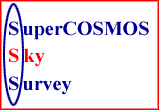
|
| SuperCOSMOS |
| Sky Surveys (SSS) |
|
|
|
|
|
|
|
|
|
|
|
|
|
|
|
|
|
|
|
| |
 | |
| IFA ROE |
Introduction
SuperCOSMOS is an advanced photographic plate digitising machine. Part of its programme is to systematically digitise sky survey plates taken with the UK Schmidt telescope (UKST), the ESO Schmidt, and the Palomar Schmidt, and to make the data publicly available. (The various different sky survey plate collections are summarised here. Details of the machine, its programme, and how to apply for a plate to be scanned can be found here.)Other digitised sky survey material is available, but the SuperCOSMOS Sky Surveys should be particularly valuable to astronomers for several reasons:
- The pixel size is 10 micron (0.7 arcsec), much smaller than the
old
DSS-I (25 micron) and still smaller than the new DSS-II (15
micron).
- Pixel images and object catalogues (to the full plate depth) are
available together in a single FITS file. We recommend using the GAIA
software package, which can browse the image and associated catalogue
simultaneously in a nice way.
- Colours, proper motions, and variability information are available for the first time in digitised sky surveys.
SKY AVAILABILITY. The whole sky is now available in three colours: blue red (two epochs) and near infra-red. To view the fields on-line go to Sky coverage.
STYLE OF ACCESS. There are four ways to access the SuperCOSMOS data.
- SMALL IMAGE/CATALOGUE. Download a small area (up to 15 arcmins)
getting
the pixel image and object catalogue for a selected region from a
selected
survey. The object catalogue is selected on the fly from a larger
database
including detections at other wavebands. (So if you select the I
survey,
your catalogue will have everything seen on the I plate, and all their
R-I
colours, but won't list things found only on the R-plate)
- LARGE CATALOGUE. Download object catalogue from a large area (up to
10
degrees across). Again, this is created on the fly from a larger
database,
taking one particular survey as the base-survey. You can control the
list
of parameters returned.
- BATCH MODE. You can specify a
disjoint list of regions (coordinates) to extract. Tar savesets of the images
and associated catalogues are returned.
- ALADIN. SSS images and catalogue data are available via the Aladin
interface at CDS.
- ALL SKY SEARCHES / ANALYSIS. It is not possible to download the whole database. However searches through the whole material can be done (e.g. "find all the objects brighter than X with proper motion larger than Y") by arrangement with the WFAU on our own machines - contact Mike Read (mar@roe.ac.uk) to discuss the possibilities. Later we hope to provide this as an automatic service.
DATA FORMAT RETURNED. If you specify that you want to see a GIF image you will see your piece of sky returned on the web page, but by default we just return the files for you to use with your own software. The images have 0.7 arcsec pixels and are returned in FITS format with a built-in World Co-ordinate System (WCS). The FITS file automatically contains FITS tables listing the associated object catalogues, and if your image viewer is smart enough (like GAIA) you can browse them simultaneously. However you can also download the catalogue separately.
The object catalogues can be returned either as FITS tables, ASCII lists, or tab-separated lists. Various database query and analysis packages (e.g. CURSA) can understand all of these formats. The parameters returned include the obvious things like RA, Dec, magnitude, colour, proper motion, but also some less obvious but often useful things like ellipticity, image area, quality and blend flags, and so on.
More detail on all these issues can be found in the various sections in the bar to the left, especially under Documentation.
Home | Intro | Get an Image | Get a Catalogue
Coverage | Documentation | History | Links
WFAU, Institute for Astronomy,
Royal Observatory, Blackford Hill
Edinburgh, EH9 3HJ, UK
M.Read@roe.ac.uk
30/7/2008
